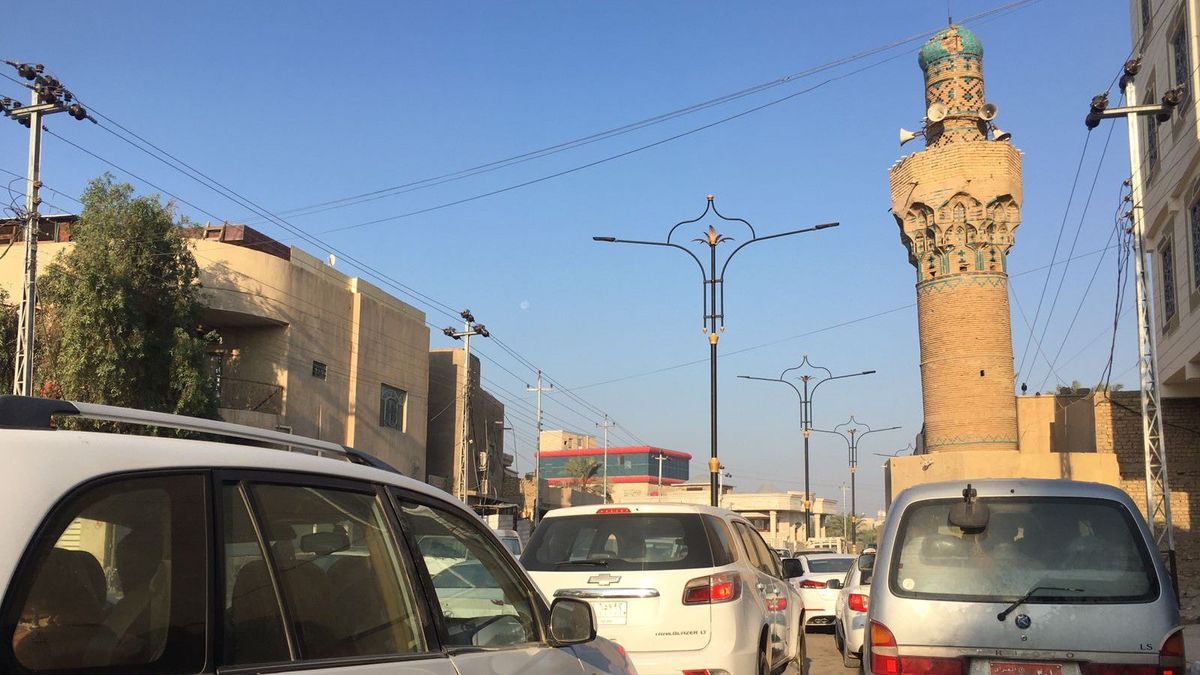The demolition of the 300-year-old minaret of a mosque in southern Iraq last week to make way for a road extension has drawn outrage from locals and heritage authorities.
The toppling of the Siraji minaret in Basra on 14 July is yet another example of the destruction of Iraqi cultural history, those who opposed the demolition say. Last week's demolition recalls the fate of the al-Nuri mosque in Mosul, currently being restored by Unesco. Although locals formed a human chain to protect the hadba minaret when the mosque was first occupied by ISIS in 2014, the beloved civic landmark was almost completely destroyed with only its base left standing in 2017.
But the historic, 11-metre-high minaret in Basra, with its brown mud brick spire and turquoise ornamentation, was destroyed not by an extremist group but by the governor of Basra, Assad Al Eidani.
Al Eidani, who personally oversaw the demolition at dawn on what was coincidentally Iraqi Republic Day, claimed that it was a necessary step for road expansion in a growing city with traffic jams. He added that it was an issue of public safety as the minaret was in danger of falling. But both the Sunni waqf (endowment) who own the land and the mosque, as well as officials from SBAH (the State Board of Antiquities and Heritage) say that the demolition violated a long-standing agreement with the Basran governate to arrange a safe removal of the historic minaret and include it in a new mosque.
While Mohammed Munla, the head of Basra’s Sunni endowment, was fired on 16 July after publicly criticising the demolition, the director of SBAH, Laith Majid Hussein, continues to express great concern. He tells The Art Newspaper: "We are shocked by this action. The minaret was of great significance. It was in very good condition and one of the few intact minarets of its era." It was also one of the few historic Sunni mosques in Basra and a special place for Eid gatherings.
While Hussein mentions “legal action” against the Basran governate for the demolition, as did Minister of Culture Ahmed Fadak al Badrani, he said that "the priority now is to try and restore the remnants of the minaret." To that end, the rubble of the minaret is in safe keeping but remains on the site of the mosque—originally built in 1727 but reconstructed in the 1980s. SBAH, he says, is consulting international experts on best practices for resurrecting the beloved Basran landmark.
Hussein cites the reconstruction of the Abbasid era minaret of Anah in the Anbar province as an example of what is possible. In the mid 1980s, when it was threatened by several new dams along the Euphrates initiated by the then-president Saddam Hussein,a team of experts dismantled the minaret into 28 pieces and relocated it to another site. In 2006 it was levelled in an explosion by unknown perpetrators that many Sunni leaders believed to be the work of Shiah militias intent on destroying cultural heritage built during the Sunni dynasties, including the statue of Caliph Mansur in Baghdad and the top of the al Malwiya minaret in Samarra. In 2013, the tower was rebuilt based on the architectural blueprint preserved by the Ministry of Tourism but was subsequently destroyed by ISIS in 2016.
Al Eidani, the son of a prominent local sheikh who fled to Iran after participating in the 1991 Shiah uprising, was arrested upon his return to Iraq and then became a key player in the 2003 de-Ba'athification purges that disproportionately affected Sunnis, has enjoyed recent popularity after Iraq's success in the Arabian Gulf Cup football tournament. With upcoming provincial elections in a few months and an outpouring of outrage at the minaret demolition on social media, his political fate remains uncertain. Whether the demolition of the minaret was motivated by sectarian politics or real estate and infrastructure development is unclear, as in Iraq these factors are often intertwined.
Meanwhile, Hussein affirms that in spite of many challenges throughout Iraq, "SBAH is on a mission to preserve our heritage." But sometimes, he says, "it seems like Mission Impossible".


